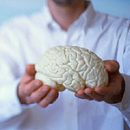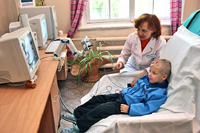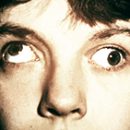What is fainting? What kinds of faint? What should be the first aid to a person who fainted? Answers to these questions you will find in the article.
Content
Fainting
So, fainting is a suddenly emerging
Short-term loss of consciousness. Fainting is a light shaped sharp
Vascular cerebral insufficiency. It is due to the lack of inflow
blood to the brain.
Faint - swoon
- Starts with a sudden lung cooling consciousness,
dizziness, ringing in the ears, yawn. Patients pale noted
cooling hands and feet, sweat drops on her face. Actions:
the patient should be immediately put on the back (in easy cases it is possible and
Just sit down with a support back on the back of the chair, chairs). Note that
under the head nothing is put! The head must be at least
one level with the case. Need to provide good oxygen access
(Often it leads to a termination of fainting) - unbutton
collar if the fall of the fallen person crowded a lot of zooak -
Persay. Need to calm the patient, emerging fear can
provoke a spasm of cerebral arteries and strengthen brain ischemia. Can
sprinkle on the face of cold water or bring to the nose moistened
alcohol. Usually, the attack of lipotimia lasts a few seconds, but, in any
case if you manage to put the patient and provide him with access
oxygen, then you can be calm, he will no longer lose consciousness.
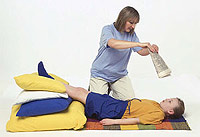 Simple faint
Simple faint
Usually also begins with bolding consciousness (t.e, like
lipotimia), and later comes a complete loss of consciousness with
turn off the muscle tone, the patient slowly settles. Arterial
Low pressure, breathing superficial, distinguishable with difficulty. Attack
Several tens of seconds lasts (up to 4-5 minutes maximum), then follows
Fast and complete recovery of consciousness. Actions:
If the patient has already lost consciousness, you do not need to tele it or try
raise. Consciousness will come back when normal
blood supply to the brain, and this requires a horizontal position
bodies (the tone of vessels is sharply reduced and if we raise your head or body,
blood simply flies into the lower limbs and for any normal
blood supply, of course, does not let you go). No need to try to find
Pulse, due to low pressure and loss of vascular tone, pulse
The wave is very weak, and you can simply not grope her. Doctors
define in such cases the pulse on the neck, on the carotid artery (if you
You think you know where the carotid artery is located, can
try to find a pulse there). Otherwise, as well as during lipotimia -
Oxygen access, ammonia. Do not seek to pour into the patient
Middle Halfwriter or wipe whiskey - this is a solution of ammonia, and he
does not restore the brain circulation, and stimulates the respiratory
Center through the nervous ending in the nasopharynk (person makes reflex
Inhale and in the body comes a large portion of oxygen with inhalation). Can,
Continuing to keep the vaccine with the nashem at the nose, cover up for a couple of seconds
Roth's palm - all the inhaled air will go through the nose and the vapor of the ammonia
in the cavity of the nose. You can, at worst, just click on
The tip of the nose - the pain stimulus is also sometimes capable
Stimulate the restoration of consciousness.
Convulsive fainting
characterized by accession to the picture of the fainting seizure (general,
generalized or single twitching of individual muscles). Basically
almost every brain hypoxia (lack of oxygen) continuing
more than 20-30 seconds., may lead to the appearance of such symptoms.
Actions do not differ from those with simple faint, but necessary
ensure that the cramp does not occur during convulsion
Head Damage, Case, Hands. Please note: cramps can
be characteristic of epileptic seven (while typical
Symptoms are a bite of the tongue, often there are scraping or moans in
the beginning of the seizure (vocalization of the seal), often appear redness
and the silence of the face) and for the hysterical seizure.
Bettoleppsia
- This fainting arising against the background of chronic lung diseases. He
due to the fact that during the protracted bouts of cough in the chest cavity
significantly increases pressure and venous outflow of blood from the cavity
Skull makes it much difficult. True, in all these cases
It is necessary to study the cardiovascular system for exception
heart disease. Special actions do not require.
The duration of fainting is most often small.
Drop Atachi
- These are unexpected, sudden falls of patients. At the same time, practically
never loss of consciousness, although there may be dizziness,
Sharp weakness. Usually observed in patients with osteochondrosis of the cervical
Spinal Department complicated by the development of Vertebro Basillar
insufficiency, as well as quite healthy young pregnant women.
Vasodepressor fainting
- More often in children, more often occurs when overwork, lack of sleep,
Emotional tension, staying in the stuffy room. It has
Pretty complex generation. Actions do not differ from
generally accepted, but careful examination is required for exception
possible diseases of the nervous system.
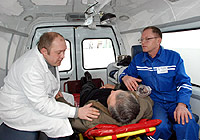 Orthostatic fainting
Orthostatic fainting
- occurs with a sharp transition from horizontal position in
vertical when the cardiovascular system does not have time
rebuilt for full provision of brain. Especially
expressed while taking beta blockers, diuretics, nitrates
and T.D. More often, however, there is no faint, and.N. Prescripts,
expressed in sudden weakness, dizziness, darkening in the eyes
When changing body position.
Hypersensitivity syndrome of carotid sinus
- proceeds by type of simple or less often, convulsive faint. Observed
Hyperactivity of carotid reflex (with carotid sinuses,
located on the front-side surfaces of the neck), which causes
Suddenly emerging bradycardia, short-term stopping of the heart,
arrhythmia. Provoking factors may be a sharp turn of the head,
Wearing tight collars - from here and conclusion: Never forget when
assistance to weaken the collar, free the neck of the victim.
Arrhythmic fainting
- Some types of arrhythmias can lead to loss of consciousness. Basic
Rhythm disorders capable of leading the loss of consciousness are
Paroxysmal atrial flutter and flicker forms full
transverse blockade, elongated Qt syndrome, paroxysmal
Stomatricular Tachycardia. Other forms of arrhythmia extremely rarely lead to
loss of consciousness, however, every patient suffering from arrhythmia (and in
features above arrhythmias), preferably
Consult the attending physician about the possibility of this
complications and, together with the doctor, develop rules of behavior that
would allow the risk of such complications to a minimum.


